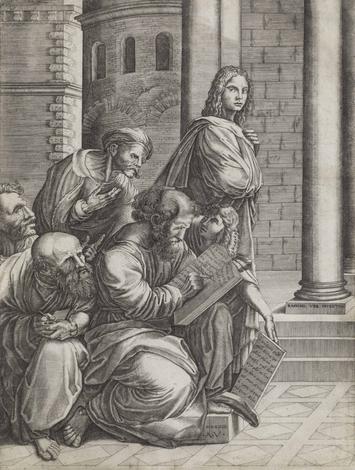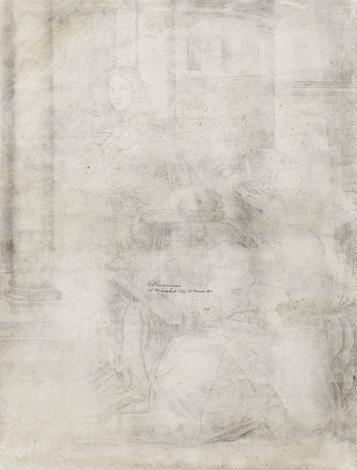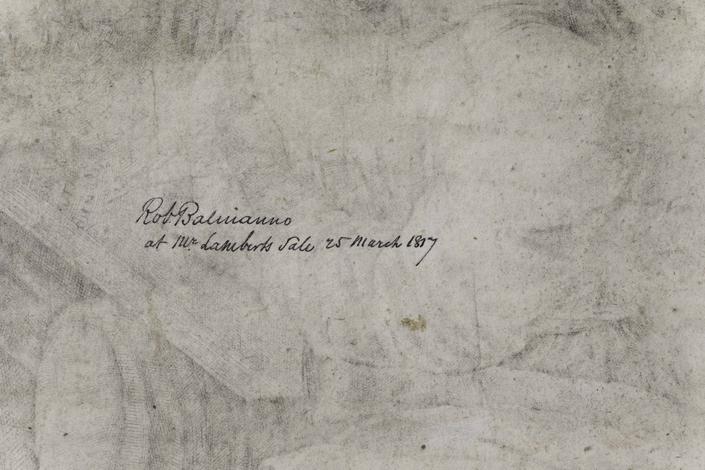DE MUSI, Agostino.
Pitagora nella Scuola di Atene (maS. Matteo e l'angelo che gli mostra il testo greco del saluto evangelico)
1524,
Foglio mm 435x326, inciso abulino, II stato/II.
Il I stato è datato 1523. Questaprova, ben contrastata nel II stato di 2 dopo il cambio della data in 1524 e i ritocchi eseguiti dall'autore, è impressa su carta della prima metà del Cinquecento, con filigrana di difficile lettura.
Stupendo soggetto tratto da un particolare dell'affresco La Scuola di Atene di Raffaello. In basso a destra sullo zoccolo della colonna "Raphael urb inventor". Al centro MDXXIIII e Monogramma A.V. con cui in genere contrassegnava i suoi lavori (la firma per esteso "Agustino di Musi" appare solo in quattro sue incisioni).Il Bellori ricorda questa incisione in cui Agostino ha trasformato la figura di Pitagora nell'Evangelista S. Matteo e il giovinetto, che si inchina di fianco con l'abaco pitagorico, in un angelo con le parole del saluto evangelico (cfr. R. Invenit). Ma la figura più potente, non solo di questa parziale incisione, ma probabilmente dell'intero affresco, è la figura giovanile in piedi che fissa fieramente il fruitore dell'opera, senza esssere guardato da altri, riconoscibile come Ipazia (IV secolo d.C.), scienziata e filosofa greca, ancora oggi simbolo della libertà di pensiero. Bell'esemplare, malgrado sia rifilata di mezzo millimetro su due lati. Al verso la data 1817 e la firma "Rob Balmanno at Mr. Lamberts sale 25 march 1817"del noto collezionista londinese R. Balmanno (1780/1863), la cui celebre raccolta è oggi in gran parte confluita al British Museum.
Agostino de Musi detto Veneziano (1490 ca. – Roma, 1540 ca.) dopo un periodo trascorso a Firenze si trasferì a Roma, dove conobbeMarcantonio Raimondi che gli fu maestro (Baldinucci, 1686).Il De Musi che generalmente contrassegnò le sue stampe con il monogramma "A. V." (Agostino Veneziano), in quattro intagli firmò per esteso come "Agustino di Musi" (S.Margherita, B. 119;Ilvecchio pastore, B.409;Gli animali, B. 414;La Vergine dalla scimmia, B. VII, 42) e in un quinto in latino: "Augustinus venetus de Musis ..." (Glischeletri, B. 424).La sua produzione incisoria - spesso di soggetti inusuali - fu assai vasta, soprattutto se rapportata al breve arco di tempo in cui fu realizzata, all'incirca tra il 1514 e il 1536. Ricevette la sua prima formazione artisticaprendendo come modello Campagnola e Dürer. Insieme a Marco Dente, contribuì con grande abilità alla prima vera e propria impresa artistico-commerciale impegnata nella riproduzione di soggetti raffaelleschi.
//ENGLISH//
Leaf (435x326 mm), engraved with burin, II state/II.
The I state is dated 1523. This evidence, well contrasted in the II state of 2 after the change of date in 1524and corrections made by the author, on paper from the first half of the 16th century, with an unidentifiable watermark.
Stunning subject from a detail of Raphael's fresco The School of Athens. Bottom right on column plinth "Raphael urb inventor." In the centre, MDXXIIII and the monogram A.V., as the author generally signed his works (the full signature 'Agustino di Musi' appears in only four engravings). Bellori refers to this engraving, in which Agustino transformed the figure of Pythagoras into the Evangelist St. Matthew, and the young man kneeling beside him with the Pythagorean abacus into an angel with the words of the Gospel greeting (see R. Invenit). However, it is the standing young figure, recognizable as Hypatia (4th century A.D.), Greek scientist and philosopher, who is the most powerful figure, not only in this particular engraving, but possibly in the entire fresco. Staring fiercely at the viewer of the work without being looked at by others, Hypatia is still a symbol of freedom of thought. Fine copy, despite being trimmed half a millimeter on two sides. Two handwritten lines are clearly legible on the verso: the date 1817 and "Rob Balmanno at Mr. Lamberts sale March 25, 1817", the signature of the famous London collector R. Balmanno (1780/1863), whose prestigious collection is now mostly held in the British Museum.
Agostino de Musi known as Veneziano (c. 1490 - Rome, c. 1540) after spending some time in Florence moved to Rome, where he met Marcantonio Raimondi, who became his teacher (Baldinucci, 1686). De Musi, who generally marked his prints with the monogram "A. V." (Agostino Veneziano), signed in full as "Agustino di Musi" in four etchings (St. Margaret, B. 119; The Old Shepherd, B. 409; The Animals, B. 414; The Virgin by the Monkey, B. VII, 42) plus a fifth in Latin: "Augustinus venetus de Musis ..." (The Skeletons, B. 424), and a fifth in Latin: "Augustinus venetus de Musis ..." (The Skeletons, B. 424). His engraving production - often depicting unusual subjects - was quite extensive, especially considering the short period in which it was produced, roughly between 1514 and 1536. He received his early artistic training by being inspired by Campagnola and Dürer. Together with Marco Dente, he contributed with great skill to the first real artistic-commercial enterprise dedicated to the reproduction of Raphael's subjects.
Bartsch, n. 492; Raphael Invenit, pp. 39-5; Mostra di Mantova, n. 237; Ex coll. Lugt, n. 213







